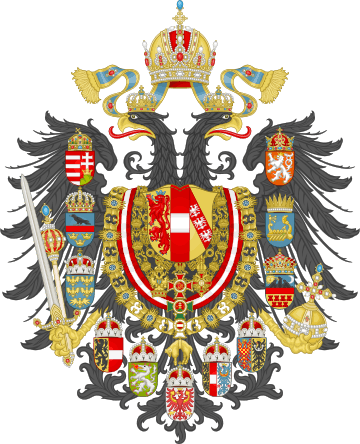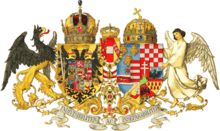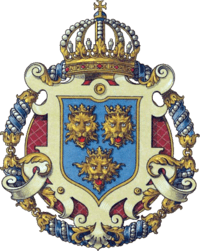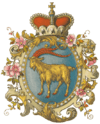Coat of arms of Austria-Hungary
The coat of arms of Austria-Hungary was that country's symbol during its existence from the Austro-Hungarian Compromise of 1867 to its dissolution in 1918. The double-headed eagle of the ruling House of Habsburg-Lorraine was used by the common Imperial and Royal (k. u. k.) institutions of the dual monarchy. Additionally, each of the two parts of the real union had its own coat of arms.

As the double-headed eagle was reminiscent of the Reichsadler insignia of the defunct Holy Roman Empire and also the symbol of the Cisleithanian ('Austrian') half of the real union, the Hungarian government urged for the introduction of a new common coat of arms, which took place in 1915, in the midst of World War I. The new insignia combined the coat of arms of the separate halves of the Dual Monarchy, linked by the armorials of the Habsburg-Lorraine dynasty and the motto indivisibiliter ac inseparabiliter ('indivisible and inseparable').
Common coat of arms
| Coat of arms | Date | Use | Description |
|---|---|---|---|
.svg.png) | 1867–1915 | Lesser common Coat of Arms | Imperial-Royal (k.k.) coat of arms of the Austrian Empire from 1804: the double-headed eagle with marshaled arms of Habsburg, Babenberg and Lorraine displayed on the Escutcheon, Order of the Golden Fleece and Imperial Crown |
 | 1867–1915 | Medium common Coat of Arms | With armorials of (counterclockwise): Hungary, Galicia, Lower Austria, Salzburg, Styria, Tyrol, Carinthia and Carniola, Silesia and Moravia, Transylvania, Illyria, and Bohemia |
.png) | 1915–1916 | Lesser common Coat of Arms | Lesser Coat of arms of Cisleithania and Transleithania under the Imperial Crown and the Crown of Saint Stephen resp., linked by the crowned Habsburg-Lorraine armorials, the Order of the Golden Fleece, and the motto indivisibiliter ac inseparabiliter |
.png) | 1916–1918 | Lesser common Coat of Arms | Lesser Coat of arms of Cisleithania and Transleithania under the Imperial Crown and the Crown of Saint Stephen resp., linked by the crowned Habsburg-Lorraine armorials, the Order of the Golden Fleece, and the motto indivisibiliter ac inseparabiliter (same as 1915 version with Croatia added to lesser arms of the Lands of the Crown of Saint Stephen) |
 | 1915–1918 | Medium common Coat of Arms | Medium Coat of arms of Cisleithania and Transleithania (see below) with supporters: a griffin in the dexter (for Austria) and an angel (for Hungary) in the sinister. |
Coat of arms of the two constituent countries
| Coat of arms | Date | Use | Description |
|---|---|---|---|
.png) | 1915–1918 | Austria's medium coat of arms | |
 | 1915–1918 | Austria's small coat of arms | |
.svg.png) | 1915–1918 | Hungary's medium coat of arms | So-called "angel coat of arms" with coats of arms of Croatia, Slavonia, Dalmatia, Bosnia and Herzegovina, Transylvania, the city of Rijeka and Kingdom of Hungary |
.svg.png) | 1916–1918 | Hungary's small coat of arms | Coats of arms of Kingdom of Hungary and Kingdom of Croatia, two kingdoms that legally made the Lands of the Crown of Saint Stephen |
Regional coat of arms
| Coat of arms | Date | Use | Description |
|---|---|---|---|
 | 1867–1918 | Kingdom of Bohemia | |
_(1868-1918).svg.png) | 1867–1918 | Kingdom of Croatia-Slavonia | Coat of arms of the Triune Kingdom |
 | 1867–1918 | Kingdom of Dalmatia | |
 | 1804–1918 | Kingdom of Galicia and Lodomeria | |
 | 1867–1918 | Duchy of Styria | |
 | 1867–1918 | Margravate of Istria | |
.svg.png) | 1878–1918 | Condominium of Bosnia and Herzegovina |
External links
| Wikimedia Commons has media related to Coats of arms of Austria-Hungary. |